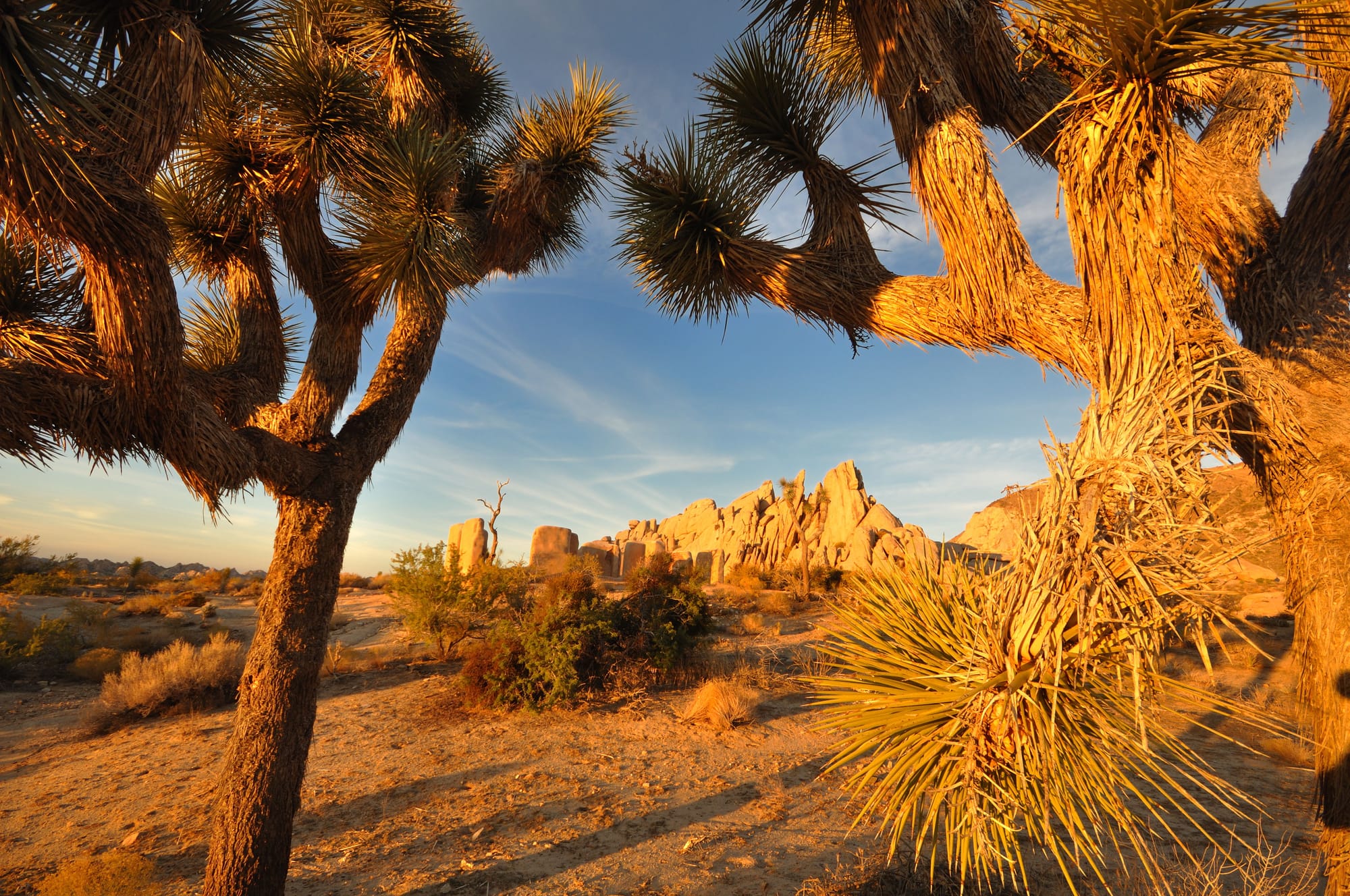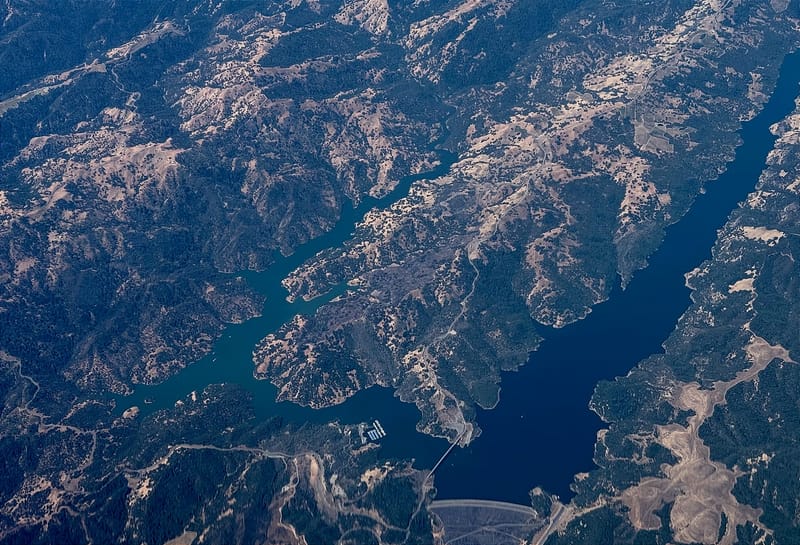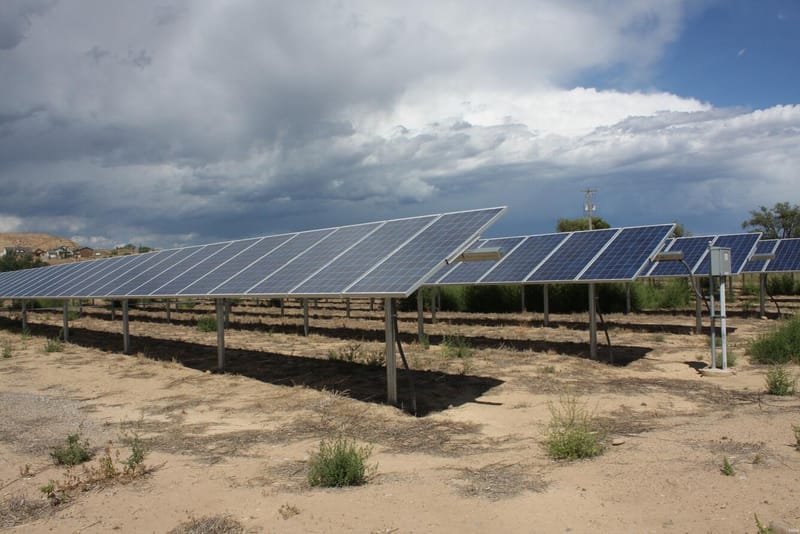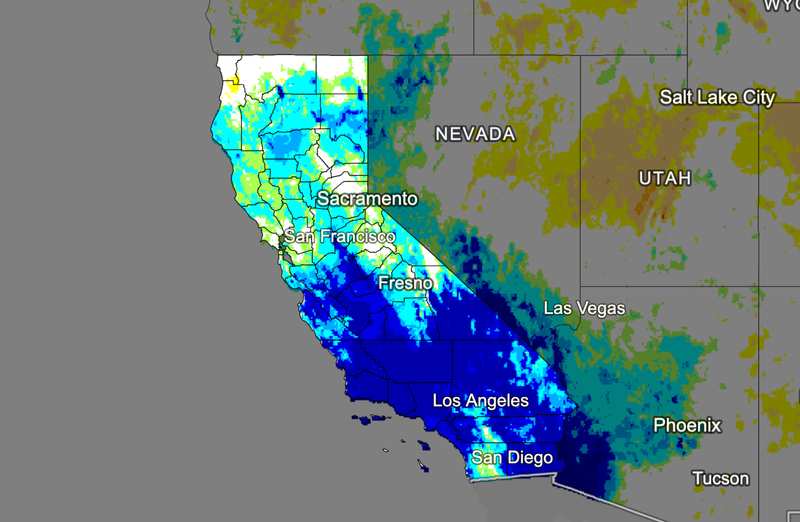California's first law to protect a species from climate change - Western Joshua Tree Conservation
This comprehensive guide details California's Western Joshua Tree Conservation Act, covering species conservation, permitting processes, mitigation, and how you can contribute to protecting this iconic desert species.
California's Western Joshua tree (Yucca brevifolia) is an iconic symbol of the state's desert landscape. The dramatic tufted trees sometimes look as if they came out of a cartoon, but they hold critical ecological value - providing habitat for birds, mammals, reptiles and insects. They also have major cultural importance to Native American tribes.
Now environmental scientists are sounding the alarm as Western Joshua trees face growing threats from climate change, wildland fires, habitat loss and other human impacts.
Those threats led California to enact the landmark Western Joshua Tree Conservation Act (WJTCA) in 2023. It is the first California law to protect a species from climate change threats.
The WJTCA created new regulations that are supposed to protect the trees and their habitat while still allowing the state's housing and renewable energy priorities to move forward. The act also requires the state to create a comprehensive Joshua tree conservation plan with strategies for the future, and that is now in the works - with an important opportunity for public comment.
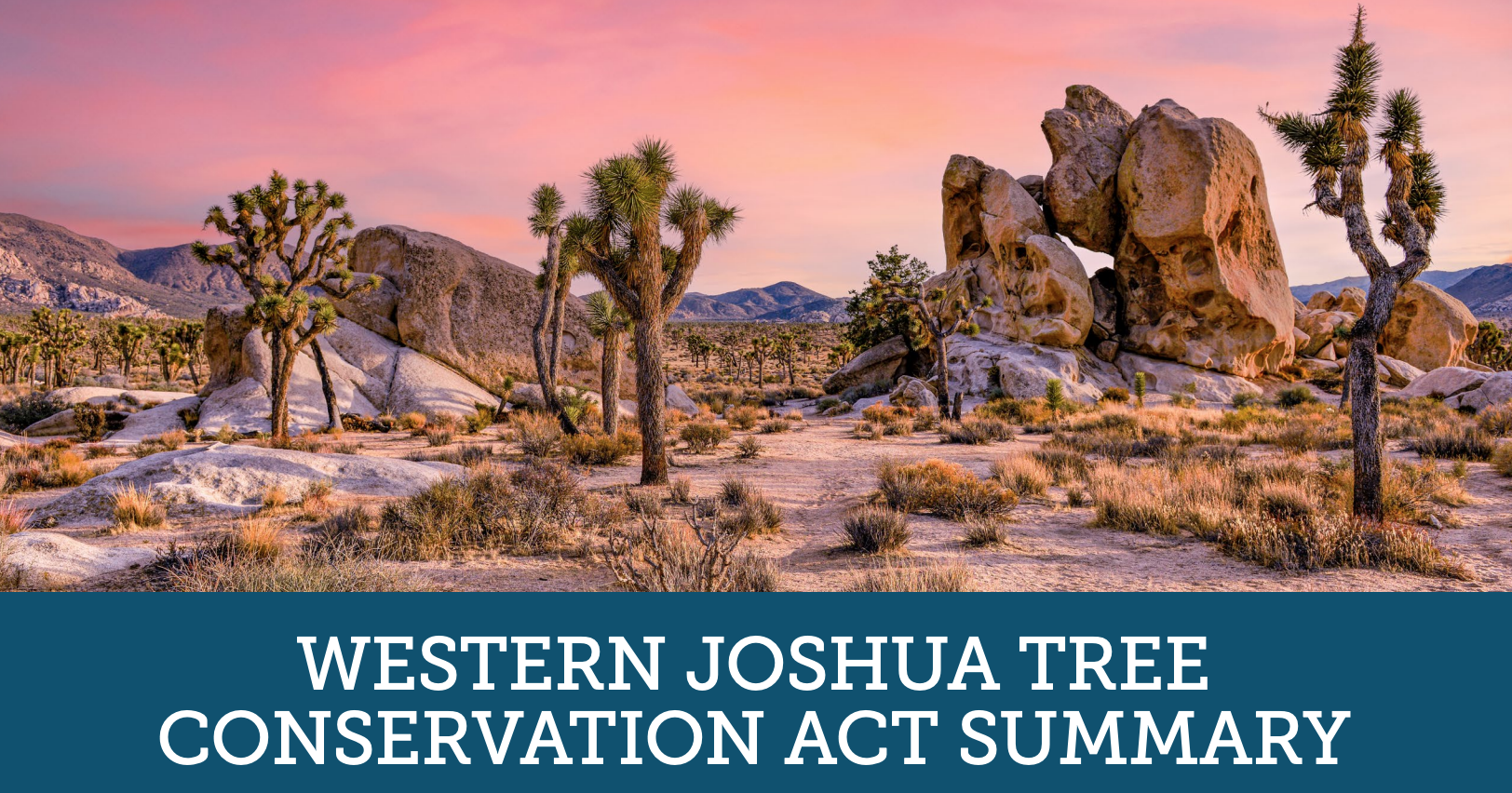
Why Western Joshua Tree Conservation Matters
Western Joshua trees are key to the health and biodiversity of California’s deserts. Some climate models indicate that without proactive measures, much of the Joshua tree’s current range could become unsuitable by the end of this century.
Overview of the Western Joshua Tree Conservation Act (WJTCA)
The WJTCA creates a framework for managing activities that may impact Western Joshua trees. The Act provides streamlined permitting procedures for certain types of construction projects. Builders have to pay mitigation fees to fund conservation initiatives designed to offset the environmental impact of their projects.
Under the WJTCA, the following activities regarding Western Joshua trees are prohibited unless authorized by the California Department of Fish and Wildlife (CDFW):
- Importing and exporting
- Removal ("take"), trimming, or possession
- Purchase and sale
Permitting Under the WJTCA
The WJTCA authorizes CDFW to issue several types of permits designed to balance development needs and conservation:
Hazard Management Permits
- Purpose: To remove or trim Western Joshua trees posing risks to structures, property, or public safety.
- Cost: Free (no mitigation fees).
- How to Apply: Applications submitted via email (WJTHazardPermit@wildlife.ca.gov).
Incidental Take Permits (ITPs)
- Purpose: Allows incidental removal or impact to Joshua trees associated with renewable energy, housing, public works, and other developments. The number of trees that can be impacted varies, depending on the specifics of the development.
- Mitigation: Permittees can opt to pay standardized fees instead of performing direct mitigation.
- Application Process: Applicants must complete a Western Joshua Tree census, fill out an application form, and submit documentation to their CDFW regional office.
Local Agreements and Delegated Permitting
The WJTCA enables CDFW to delegate limited permitting authority to counties and cities. Local governments can issue permits for certain residential and public works projects, as well as permits for the trimming and removal of dead or hazardous Western Joshua trees.
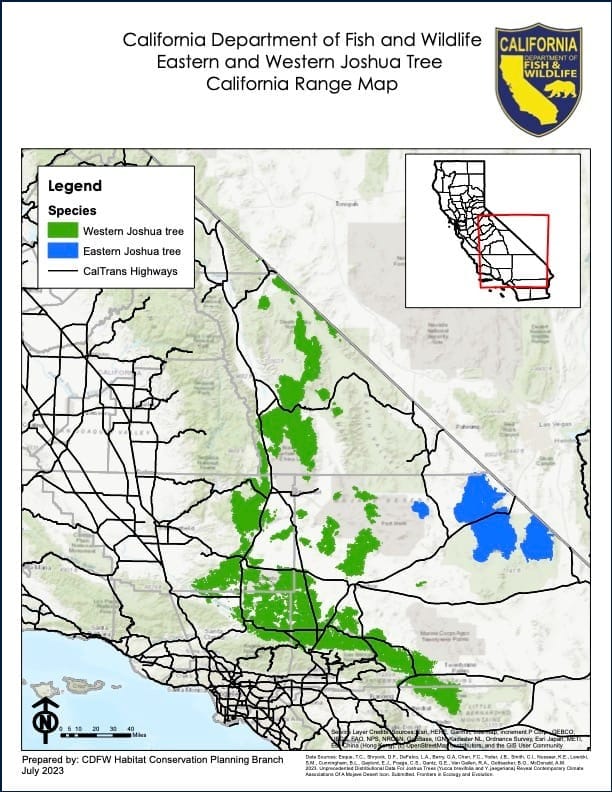
Western Joshua Tree Conservation Plan
As required by the WJTCA, CDFW has developed a draft of a new comprehensive Western Joshua Tree Conservation Plan. The plan outlines key strategies including:
- Habitat Conservation: Acquisition, protection, and management of Western Joshua tree habitats.
- Mitigation Guidelines: Methods to minimize impacts from development.
- Tribal Co-Management: Engaging California Native American Tribes in conservation management.
- Public Outreach and Education: Informing the public about Joshua tree conservation efforts.
- Research Initiatives: Gathering data to inform long-term conservation actions.
The draft Conservation Plan will be reviewed publicly by California’s Fish and Game Commission, with adoption required by June 30, 2025.
Review the Draft Conservation Plan:
How You Can Participate and Comment
The Fish and Game Commission encourages public involvement throughout the Conservation Plan adoption process. Comments can be submitted by:
- Email: fgc@fgc.ca.gov
- Mail: California Fish and Game Commission, P.O. Box 944209, Sacramento, CA 94244-2090
- Public Meetings: Attend in-person or virtually during scheduled commission meetings.
Important Upcoming Dates:
- April 16-17, 2025: California Fish and Game Commission Meeting, expected to include presentation of amendments and further comment opportunity.
- Link to meeting schedule: https://fgc.ca.gov/Meetings/2025
- June 30, 2025: Deadline for Commission adoption
Frequently Asked Questions (FAQs)
The FAQs and answers below are transcribed directly from the California Department of Fish and Wildlife's official FAQ page on Western Joshua Tree conservation.
Under the WJTCA Hazard Management Permit, CDFW is only able to authorize trimming of living WJTs, not removal. You may submit an application to trim a living WJT that indicates which limb or limbs to be removed meet one of the following conditions:
- Has fallen over and is within 30 feet of a structure;
- Is leaning against an existing structure; or
- Creates an imminent threat to public health and safety
The trimming of a live WJT may not result in the mortality of the tree (i.e., trees cannot be trimmed to the ground so no live branches are remaining).
To trim or remove a hazardous WJT on your property you should visit the How-to-Guide under our permitting page to determine if you qualify for a WJTCA Hazard Management Permit. A permit may be issued to a property owner under certain circumstances. A qualified desert native plant specialist is required to assist with removal or trimming of live trees. Visit WJT Permitting page to learn more about hazard tree permits.
The permit must be completed by the property owner. If the tree is on county or city property you will need to report it to the city or county so they may request a Hazard Management Permit.
Yes. The WJTCA Hazard Management Permit (HMP) allows you to apply for a single permit to manage multiple WJTs and management needs on your property as long as the trees meet the HMP qualifying conditions. Your permit application must include photographs of the WJTs that visually depict the dead tree(s) and/or the tree(s) to be trimmed.
There are no fees associated with applying for a WJTCA Hazard Management Permit.
Under the WJTCA, a desert native plant specialist is defined as an arborist certified by the International Society of Arboriculture (ISA), or an individual with at least five years of professional experience with relocation or restoration of native California desert vegetation. Certified arborists can be found on ISA's Find an Arborist site (treesaregood.org)(opens in new tab). A professional native California desert plant relocation or restoration specialist can usually be found working for landscaping companies or environmental consulting firms throughout Southern California.
Western Joshua Tree Hazard Management Permits
- If a western Joshua tree creates an imminent threat to public health and safety, the department will issue a permit allowing for the removal or trimming within 10 days of receipt of a request for a permit.
- If a western Joshua tree has fallen over and is within 30 feet of a structure or is leaning against an existing structure, the department will issue a permit allowing for the removal or trimming within 30 days of receipt of a request for a permit.
WJTCA Incidental Take Permits do not have any statutory timelines. CDFW will process the applications as expeditiously as possible.
As of December 2023, no cities or counties have delegation authority agreements with CDFW. When those agreements are established, an announcement will be made through the Western Joshua Tree Conservation Updates email list(opens in new tab) and posted on the CDFW Western Joshua Tree Permitting page.
There is no limit to the number of WJTs that can be taken under a WJTCA permit through CDFW.
There is a limit to the number of trees that can be taken associated with a WJTCA Incidental Take Permit through a delegation agreement with a city/town/county. Under those permits, a project can take no more than 10 individual trees on the project site for construction of a single-family residence, multifamily residence, or accessory structure, or no more than 40 individual trees on the project site where a public agency proposes a public works project involving the erection, construction, alteration, repair, or improvement of any public structure, building, road, or other public improvement of any kind.
CDFW is responsible for issuing permits for take of WJT under the WJTCA. CDFW may enter into an agreement with a county or city to delegate to the county or city to authorize the removal or trimming of dead WJTs, trimming of live WJTs, and removal of WJTs associated with developing single-family residences, accessory structures, and public works projects. If you have a project falling into those categories, please check with your county or city to see if they have entered into an agreement with CDFW to issue permits. If so, please work with your local city or county to obtain permit guidance. If your local county or city has not entered into an agreement with CDFW to issue permits, or if your project does not fall into those categories, please contact CDFW for permitting guidance.
You are also responsible for complying with all other federal, state, and local laws and regulations that are applicable to your activities. If obtaining your permit through CDFW, please check with your city or county, as they may have additional ordinances or rules relating to WJT.
Applicants may choose to obtain a permit through a city/county, if a delegation agreement is in place and their project meets the parameters for delegated agreements or go through CDFW. However, there may be some benefits to choosing a city/county permit such as a reduced mitigation fee, depending on the location of your project.
The WJTCA continues the existing prohibition on importation, export, take, possession, purchase, or sale of any WJTs in California unless authorized by CDFW. You can report any violations of the WJTCA through the CalTIP Program.
In the wild, western Joshua trees are geographically separated from eastern Joshua trees, hence, their name. The map below shows the natural range of each species.
Western Joshua trees typically have a distinct central trunk that usually branches higher off the ground than eastern Joshua trees. Additionally, a western Joshua tree may have clonal growth from the base of the trunk and be more bush-like in appearance. On western Joshua trees, the first branches usually split between 3-10 ft from the ground whereas eastern Joshua trees usually branch below 3ft. Western Joshua trees have slightly larger leaves compared to eastern Joshua trees. The flower characteristics also differ between western and eastern Joshua trees. Western Joshua tree flowers are more spherical, the tips of flower petals curve inwards, and are a cream color. Eastern Joshua tree flowers are more bell-shaped, the flower tips curve outward at full bloom, and can be a slightly greenish to cream color.
If you are unsure what kind of Joshua tree may be within your project footprint, please contact a Desert Native Plant Specialist for assistance.
In-lieu fees streamline the approach to permitting and will allow permittees to satisfy mitigation obligations by paying a set amount for the take of each individual WJT, based on the tree’s height and location. All in-lieu fees collected under the WJTCA will be deposited into the Western Joshua Tree Conservation Fund to be used to address threats to the WJT, including through the acquisition, conservation, and management of WJT conservation lands.
Yes. The species will retain its candidate status until the California Fish and Game Commission formally votes to list WJT as endangered or threatened under the California Endangered Species Act (CESA), or to deny the pending listing petition. However, important state law options now exist pursuant to the WJTCA.
While the WJT is a candidate species, WJT take permitting options are available under the WJTCA, CESA, and the NCCP Act. If the Commission later determines that listing the WJT as endangered or threatened pursuant to CESA is warranted, the WJTCA will become inoperative and the authorization of take of a WJT will only be allowed under CESA or pursuant to the NCCP Act. However, regardless of CESA status, the WJT Conservation Plan will continue to guide conservation of this species, CDFW will remain committed to co-management of the species with California Native American tribes, and the WJT Conservation Funds will be used for acquisition, restoration, and other conservation actions for the benefit of WJT.
Yes. On April 21, 2022, CDFW submitted a WJT status review report to the California Fish and Game Commission (Commission) evaluating whether listing the species as endangered or threatened under the California Endangered Species Act would be warranted. Under the WJTCA, CDFW must prepare and submit an updated status review to the Commission by January 1, 2033, unless the Commission directs CDFW to complete it sooner.
Importantly, for that future update, the WJTCA requires CDFW to incorporate any new scientific information and include an evaluation of the impact of any conservation and management efforts. This means implementation of the unique attributes of the WJTCA approach such as in-lieu fee, delegation of local authority, permitting streamlining, and landscape conservation will all be factored into any future management decisions by the Commission.
The WJTCA effectively creates an implementation period for everyone to work together to conserve the tree, implement the conservation plan, and illustrate the efficiencies of the streamlined, unique permitting mechanisms like in-lieu fees and local government delegation.
More Questions?
Contact your CDFW regional office or email WJT@wildlife.ca.gov.
Contact Information
For further details, permitting assistance, or additional questions, please contact:
- General Questions: WJT@wildlife.ca.gov
- Region 4 (Central California): (559) 243-4005, reg4sec@wildlife.ca.gov
- Region 5 (Southern California Coast): (858) 467-4201, AskR5@wildlife.ca.gov
- Region 6 (Inland Deserts): (909) 484-0167, AskRegion6@wildlife.ca.gov


